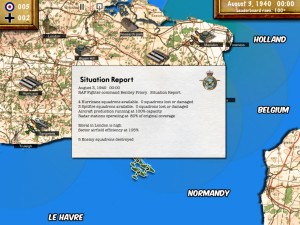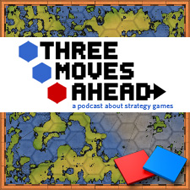It’s weird when someone directly addresses a game design question you’ve been puzzling over, but never thought would be answered. Last year, I wrote a series of articles about simulation, Gary Grigbsy’s Eagle Day, and the Battle of Britain. I started out wondering how you’d ever make a casual Euro out of something like the Battle of Britain and still keep it historical. Karl Thoroddsen, designer of a new iPad app called The Blitz, had a solution.
Make it a tower defense game.
The Blitz is actually three air war games in one, but it’s clear which one is the focus. Depicting just Kent, Sussex, and Greater London, The Blitz gives you control of a few Spitfire and Hurricane squadrons, several “sector airfields,” a bunch of radar towers, and starts throwing Luftwaffe at you. The mechanics are simple: watch German planes appear on the screen, and send your fighters to intercept them. Just swipe a path for your squadron to follow and watch it fly off to … whoops, didn’t quite intercept. Need to redirect. Oh man, there’s another raid. Gotta send another squadron out. Hey, where did that plane come from? There’s no way I can get there before he bombs the Spitfire factory. Air raid London!
That’s the kind of fast-paced defense of democracy you don’t get in a historical wargame, which makes sense because this isn’t one. In order to make this work, The Blitz discards a whole bunch of historical facts, such as that single raids didn’t permanently knock out radar stations, or that unopposed fighter sweeps didn’t destroy entire squadrons on the ground, or that two successful raids on London didn’t force England to surrender. Those are all game mechanics that make The Blitz a pretty good tower defense game, but a lousy historical wargame. Which was probably the tradeoff Karl Thoroddsen had in mind all along.

The historical liberties are more apparent in the other two scenarios, “Defense of the Reich” and “Operation Tidal Wave.” The former is set in 1944 and pits wave after wave of Flying Fortresses and Liberators against a threadbare German defense of single-seat interceptors, twin-engine night fighters, and Me 262 jets. The target is Berlin, and, as before, two hits and you’re done. This scenario adds antiaircraft batteries, which aren’t very effective at stopping anything and thus are probably the most historically accurate thing in the whole game. Radar towers, aircraft factories, research centers, and airfields are all vulnerable to attack, but this time bombers come from all points of the compass, often simultaneously. In addition, Allied interceptors swarm the map, strafing airbases and tangling with your fighters. If Hitler had lived in this reality, the war would probably have ended much sooner.
The last scenario is the oddest, as it depicts the first, Pyrrhic American raid on the Ploesti oil fields, carried out at the limit of strategic bombing range, far beyond any hope of escort, and into the teeth of some of the strongest air defenses in Europe at that time. “Operation Tidal Wave” (the correct historical name, by the way) flips this around to where American bombers are coming out of every which place, and the Germans have few fighters and no reinforcements. It’s probably not surprising that of the hundred or so people on the leaderboard for the Blitz scenario, only seven tried out the defense of Ploesti.
The main problem with The Blitz isn’t anything inherently ahistorical — it’s that you get a lot of choices, but only a few are really interesting. The most important is whether to keep your squadrons grounded until you spot an enemy raid, or whether to fly standing patrols, given that your aircraft have limited fuel and will need to return to base. Limited warning (made worse if you lose your radar stations) keeps you guessing as to whether a raid is bombers and fighters or just unescorted bombers, although you can usually tell a fighter sweep just by the planes’ speed. Being caught on the ground by fighters is costly, and you’ll often scramble planes just to get out of the way as a fighter sweep passes, only to land once the danger is gone. No perfect answer exists, and you’ll use your warning system, some intelligence reports (broadcast as text messages) and your intuition to put up a defense. This part works.
Other parts don’t, or at least aren’t very well tuned. You can upgrade your airbases with an engineer unit (depicted as a wrench, which also fixes damage) which is supposed to improve defense and turnaround time, but this isn’t really noticeable. Aircraft gain experience by shooting down enemies, but once again, the performance improvement doesn’t appear to make much practical difference. There are research centers which periodically upgrade your planes, but — you guessed it — this is so incremental that I couldn’t tell which ones had the bonus. The aforementioned AA guns are pretty useless and are just player distractions. Factories turn out additional planes, and these are worth protecting because numbers end up being the overriding factor The Blitz. Fight too many times with a Hurricane squadron and you’ll lose the whole thing, even to a single flight of unescorted Heinkels. The design clearly focuses on patrol patterns and turn-around time rather than building super-squadrons or bases, but without the continuous tweaks and temporary advantages other tower defense games give you as you progress, it can feel like you’re actually swimming backwards.
Part of this is due to the fact that unlike a conventional tower defense game, there aren’t any waves or stages: you just keep fighting until you lose. There are two modes: campaign and survival, although it’s not clear what the difference is. The survival mode times you, while the campaign just gives you credit for finishing. After several shots at the Blitz scenario, I made it to #27 on the leaderboard, out of 107. Scores are measured in time survived, and the top one was approximately twice mine. I guess I’m lucky I didn’t have to defend England in the actual war with an actual iPad.
The game is clearly still under development, as evidenced by the fact that there is a grayed-out Midway scenario in the list, described as “work continues.” If you click on the feedback button on the app’s start screen, you should mention that the leaderboards, achievements, and endgame stats all need work. How many bombers did I shoot down? How many fighters? What was my highest-scoring squadron? Why aren’t there more achievements than just finishing each campaign, especially since I’m not likely to do that anytime soon?
The Battle of Britain scenario has a two-player option if both people are sitting at the same iPad, in which the German player chooses raid composition and targets, but this is clearly a solo tower defense game, and any improvement is going to come from tweaking those elements, not fussing with a two-player mode almost no one will play. Since the game costs 99 cents, it would probably take less time to just pay a buck and check it out than read a thousand words about me having checked it out. In that case, consider this a form of extended feedback. Just paste it into the Feedback box and hit “Send.”



